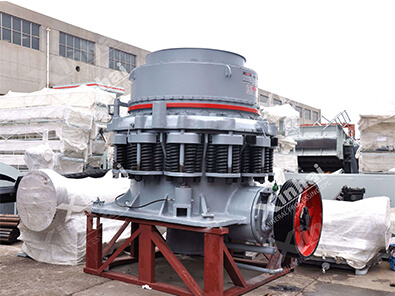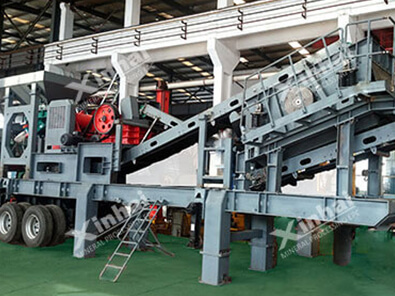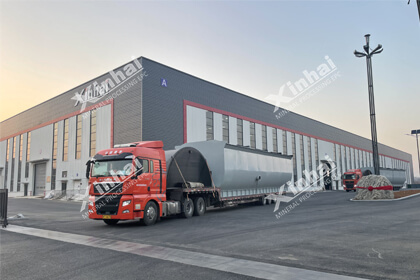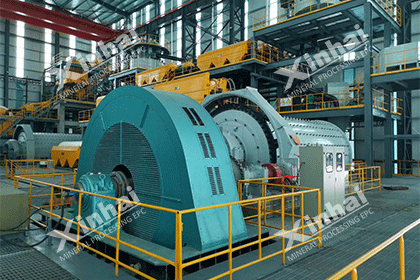A Comprehensive Guide on Mining Crushing Equipment
 Essow
Essow
 Apr 27, 2024
Apr 27, 2024
 5129
5129
If you want to know more details about equipment, solutions, etc, please click the button below for free consultation, or leave your requirements!
The mining industry relies heavily on efficient and reliable crushing equipment to extract valuable minerals from the earth's crust. Crushing equipment plays a crucial role in reducing the size of large rocks and ores, making them suitable for further processing. This article explores the various types of crushing equipment used in the mining industry, their working principles, and the benefits they offer in terms of improving efficiency and productivity.
01 Jaw Crushers
BackJaw crushers are widely used in the mining industry for primary crushing. They consist of a fixed jaw plate and a movable jaw plate. The rocks or ores are fed into the crushing chamber, and the movable jaw exerts pressure on the material, breaking it into smaller pieces. Jaw crushers are known for their high capacity, versatility, and ease of maintenance. They are suitable for various types of ores, including hard and abrasive materials.
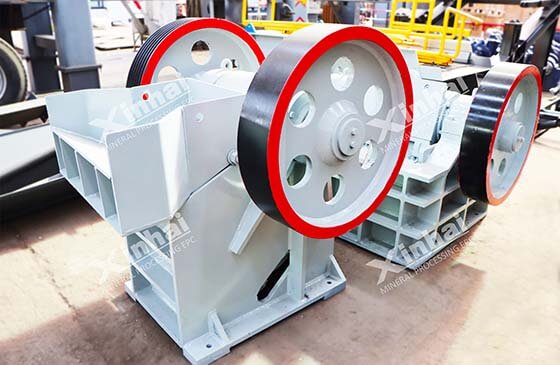
(Jaw Crusher)
Jaw crushers are widely used in the mining, construction, and recycling industries for primary crushing of various materials. They are characterized by their sturdy construction, high capacity, and versatility. Here are some key aspects to know about jaw crushers:
1. Structure and Components
A typical jaw crusher consists of a fixed jaw plate and a movable jaw plate. The fixed jaw is mounted on a fixed frame, while the movable jaw is attached to a toggle plate, which is connected to an eccentric shaft. The movement of the toggle plate causes the movable jaw to move back and forth, exerting pressure on the material.
2. Crushing Process
The rocks or ores are fed into the crushing chamber between the fixed and movable jaws. As the movable jaw moves back and forth, it exerts compressive force on the material, crushing it against the fixed jaw. This action breaks the material into smaller pieces. The crushed material then exits through the discharge opening at the bottom of the crusher.
3. Advantages of Jaw Crushers
Versatility: Jaw crushers can handle a wide range of materials, including hard and abrasive ores, as well as various rock types.
High Capacity: Jaw crushers are designed to handle large feed sizes and have high throughput capabilities, making them suitable for primary crushing applications.
Simple Structure: The basic design of jaw crushers facilitates easy operation and maintenance.
Adjustable Discharge Opening: The discharge opening can be adjusted to control the size of the crushed product, allowing for desired particle size distribution.
4. Types of Jaw Crushers
Blake Jaw Crusher: The Blake jaw crusher features a fixed jaw plate and a movable jaw plate. It is named after the inventor, Eli Whitney Blake. This type of jaw crusher is commonly used for coarse crushing of ore and hard rock materials.
Dodge Jaw Crusher: The Dodge jaw crusher has a variable feed area and a fixed discharge area, which leads to a gyratory movement of the movable jaw. It is used in primary crushing applications and is known for its simplicity and low cost.
Universal Jaw Crusher: The universal jaw crusher combines the advantages of both the Blake and Dodge jaw crushers. It has a fixed feed area and a variable discharge area, allowing for greater flexibility in crushing various materials.
5. Applications
Jaw crushers are widely used in various industries, including mining, quarrying, construction, and recycling. They are primarily used for primary crushing operations, where large rocks or ores need to be reduced in size for further processing. Jaw crushers are commonly used in the mining industry to crush materials such as granite, basalt, gneiss, limestone, and iron ore.
02 Cone Crushers
BackCone crushers are commonly used for secondary and tertiary crushing in mining operations. They feature a cone-shaped crushing chamber where the rocks or ores are compressed between a mantle and a concave. Cone crushers offer advantages such as high crushing efficiency, uniform particle size, and excellent particle shape. They are ideal for processing medium-hard to hard materials and are widely used in the mining industry for crushing ores, including iron, copper, and gold.
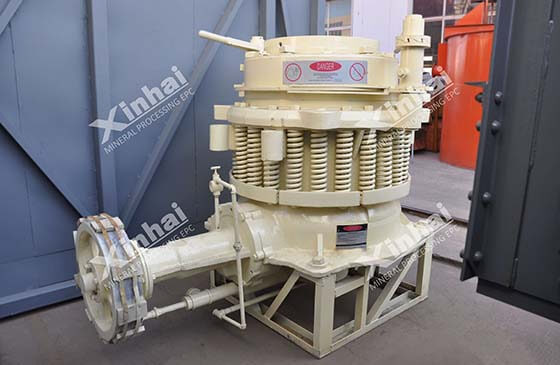
(Cone Crusher)
Cone crushers are widely used in the mining and aggregate industries for secondary and tertiary crushing of various materials. They are known for their efficiency, uniform particle size, and excellent particle shape. Here are some key aspects to know about cone crushers:
1. Structure and Components
A cone crusher consists of a cone-shaped crushing chamber, a mantle (fixed cone), a concave (movable cone), and an eccentrically rotating shaft. The rocks or ores enter the crushing chamber from the top and are crushed between the mantle and the concave. The mantle gyrates or rotates, causing the material to be compressed and fractured.
2. Crushing Process
The rocks or ores are fed into the cone crusher's crushing chamber from the top. The eccentrically rotating shaft causes the mantle to move in a circular motion, squeezing the material against the concave. This compression process breaks the material into smaller pieces. The crushed material then exits through the discharge opening at the bottom of the crusher.
3. Advantages of Cone Crushers
High Crushing Efficiency: Cone crushers are designed to provide high crushing efficiency due to their large crushing force and optimized crushing chamber.
Uniform Particle Size: Cone crushers produce a more uniform-sized product compared to other crushers, resulting in better particle shape and reduced fines.
Versatility: Cone crushers can handle a wide range of materials, including hard and abrasive ores, as well as various rock types.
Adjustable Discharge Opening: The discharge opening can be adjusted to control the size of the crushed product, allowing for desired particle size distribution.
Protection System: Many cone crushers are equipped with advanced hydraulic systems and overload protection mechanisms to prevent damage from uncrushable materials or excessive loads.
4. Types of Cone Crushers
Standard Cone Crusher: This type of cone crusher is used for general crushing applications and is available in various sizes. It is suitable for secondary and tertiary crushing.
Short Head Cone Crusher: The short head cone crusher has a steeper crushing chamber and a smaller feed opening. It is typically used for finer crushing operations and is commonly used in the final stages of crushing.
Compound Cone Crusher: The compound cone crusher combines the advantages of both the standard and short head cone crushers. It is designed to provide high productivity and good particle shape.
5. Applications
Cone crushers are widely used in various industries, including mining, aggregate, road construction, and chemical industries. They are primarily used for secondary and tertiary crushing, where the feed material is smaller in size and requires finer crushing to produce high-quality end products. Cone crushers are commonly used to crush materials such as granite, basalt, limestone, and iron ore.
03 Impact Crushers
BackImpact crushers are versatile machines that can handle a wide range of materials, from soft to hard and from brittle to tough. They operate by delivering high-speed impact blows to the material, causing it to break along natural fault lines. Impact crushers are known for their high reduction ratios and excellent cubicity of the crushed product. They are commonly used in mining applications for processing various types of ores, including limestone, coal, and phosphate.
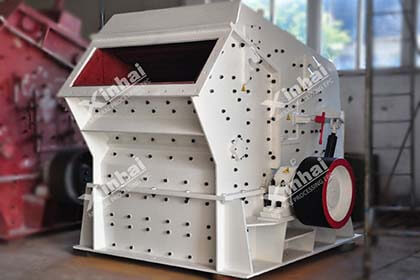
(Impact Crusher)
Impact crushers, also known as impactors or horizontal shaft impactors (HSIs), are commonly used in the mining, aggregate, and construction industries for crushing a variety of materials. They are versatile machines that can handle both soft and hard rocks with high efficiency. Here are some key aspects to know about impact crushers:
1. Structure and Components
An impact crusher consists of a rotor, which revolves at high speed, and a feed chute that directs the material into the crushing chamber. The rotor is equipped with blow bars or hammers that impact the material and cause it to break. The crushed material is then discharged through an opening at the bottom.
2. Crushing Process
The material enters the impact crusher through the feed chute and comes into contact with the rotating blow bars or hammers. The high-speed impact of the blow bars transfers energy to the material, causing it to shatter and break into smaller pieces. The broken fragments then move towards the discharge opening and exit the crusher.
3. Advantages of Impact Crushers
High Reduction Ratio: Impact crushers are designed to provide a high reduction ratio, meaning they can efficiently reduce the size of the material.
Versatility: Impact crushers can handle various materials, including soft and hard rocks, and are suitable for both primary and secondary crushing.
Good Particle Shape: Impact crushers produce a cubical-shaped end product, which is desirable for many applications such as concrete and asphalt production.
High Capacity: Impact crushers can handle large feed sizes and have high throughput capabilities, making them suitable for processing large quantities of material.
Adjustable Discharge Opening: The discharge opening can be adjusted to control the size of the crushed product.
4. Types of Impact Crushers
Horizontal Shaft Impact Crusher (HSI): This type of impact crusher has a horizontal shaft that generates a high-speed impact force. The material is fed into a feed chute, and the high-speed rotor impacts the material, causing it to break and disperse.
Vertical Shaft Impact Crusher (VSI): In a vertical shaft impact crusher, the rotor is mounted vertically and rotates at high speed. The material is fed into the center of the rotor, and centrifugal force throws it outward against the anvils or impact plates. This type of crusher is particularly used for producing high-quality manufactured sand and cubical-shaped aggregates.
5. Applications
Impact crushers are widely used in various industries, including mining, aggregate, construction, and recycling. They are commonly used for primary, secondary, or tertiary crushing of materials such as limestone, concrete, asphalt, and ores. Impact crushers are also used in the production of artificial sand and are often utilized in quarry operations.
04 Mobile Crushing Plants
BackMobile crushing plants have revolutionized the mining industry by providing flexibility and mobility in crushing operations. These plants consist of multiple crushing units mounted on a wheeled or tracked platform, allowing them to be easily transported between different mining sites. Mobile crushing plants enable on-site crushing, reducing the need for costly transportation of materials. They enhance productivity and efficiency in mining operations, especially in remote areas.
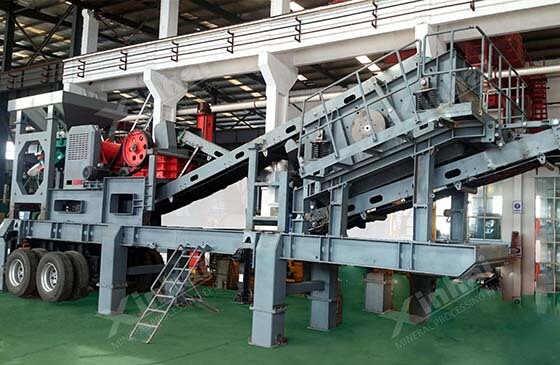
(Mobile Crushing Plant)
Mobile crushing plants, also known as mobile crushers or portable crushers, are designed to move easily and efficiently between job sites. They are self-contained crushing units that are mounted on a wheeled or tracked chassis, allowing for flexibility in transportation and operation. Here are some key aspects to know about mobile crushing plants:
1. Mobility and Portability
Mobile crushing plants are specifically designed to be mobile and easily transported between different locations. They can be quickly set up at a new job site, allowing for on-site crushing of materials without the need for extensive infrastructure or specialized equipment. This mobility enables contractors and operators to bring the crushing process closer to the source of material, reducing transportation costs and improving efficiency.
2. Components and Features
Mobile crushing plants typically consist of a primary crusher (such as a jaw crusher or impact crusher), a secondary crusher (such as a cone crusher), a vibrating screen, and a conveyor system for handling the crushed material. Some mobile plants may also include additional components such as a pre-screen, a magnetic separator, or a dust suppression system. These features enhance the versatility and efficiency of mobile crushing plants for various applications.
3. Versatile Crushing Capabilities
Mobile crushing plants can handle a wide range of materials, including hard rocks, ores, and recycled concrete. They are commonly used in construction, mining, quarrying, and recycling applications. The ability to crush on-site eliminates the need to haul material to a stationary plant, saving time and reducing transportation costs.
4. Flexibility in Configuration
Mobile crushing plants offer flexibility in configuration to meet specific crushing requirements. They can be equipped with different types of crushers, such as jaw crushers, impact crushers, or cone crushers, depending on the desired final product size and application. Additionally, modular mobile crushing plants allow for easy interchangeability of components, enabling customization and adaptation to different job site conditions.
5. Benefits of Mobile Crushing Plants
Increased Efficiency: Mobile crushing plants provide efficient on-site crushing, reducing the need for material transportation and optimizing the production process.
Cost Savings: By eliminating or reducing the need for hauling material to a stationary plant, mobile crushing plants help save on transportation costs.
Environmental Considerations: Mobile crushing plants can contribute to environmental sustainability by reducing the carbon footprint associated with material transportation.
Quick Setup and Disassembly: Mobile plants can be set up and dismantled quickly, allowing for rapid deployment and relocation between job sites.
6. Advanced Technologies
Mobile crushing plants are incorporating advanced technologies to enhance their performance and productivity. This includes features such as remote control operation, wireless communication, telematics systems for monitoring and optimizing plant performance, and automation for improved efficiency and safety.
05Conclusion
BackEfficient and reliable crushing equipment is essential for the mining industry to extract valuable minerals effectively. Jaw crushers, cone crushers, impact crushers, gyratory crushers, and mobile crushing plants are among the key types of equipment used in mining operations. Each type offers unique advantages in terms of crushing efficiency, capacity, and versatility. By selecting the appropriate crushing equipment for specific mining applications, operators can significantly enhance their productivity and profitability. It is crucial to consider factors such as the type of material being crushed, desired product size, capacity requirements, and maintenance considerations when choosing crushing equipment. Continuous advancements in technology and design continue to improve crushing equipment, allowing the mining industry to extract minerals more efficiently and sustainably.
 +86 183 3575 8886
+86 183 3575 8886 pinklaurabao@gmail.com
pinklaurabao@gmail.com




 Message
Message Chat Now
Chat Now



